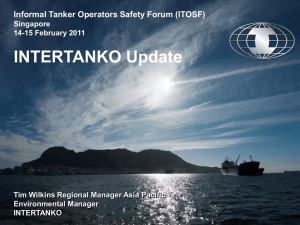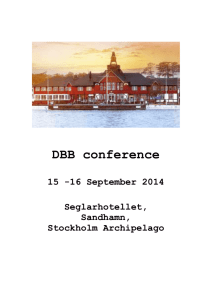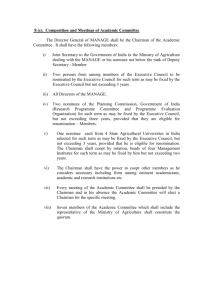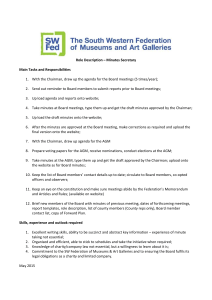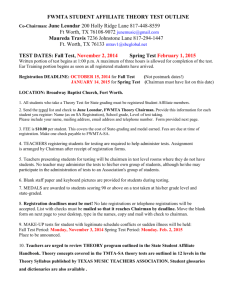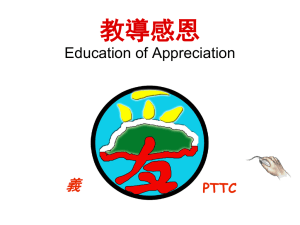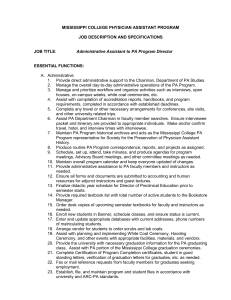- Intertanko
advertisement
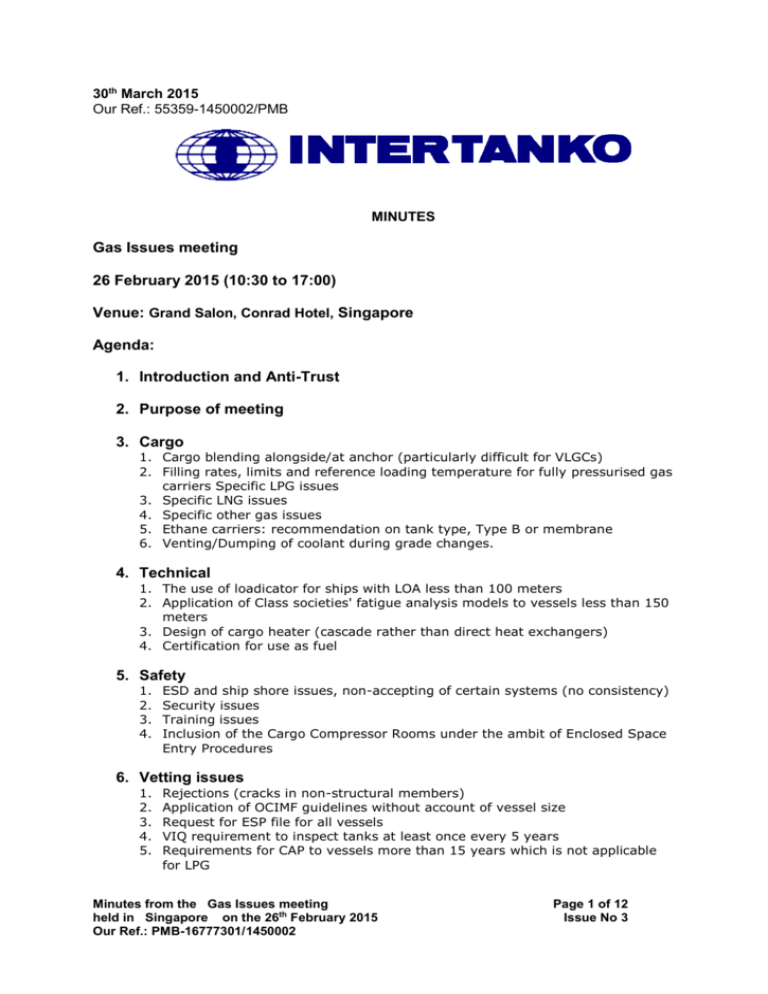
30th March 2015 Our Ref.: 55359-1450002/PMB MINUTES Gas Issues meeting 26 February 2015 (10:30 to 17:00) Venue: Grand Salon, Conrad Hotel, Singapore Agenda: 1. Introduction and Anti-Trust 2. Purpose of meeting 3. Cargo 1. Cargo blending alongside/at anchor (particularly difficult for VLGCs) 2. Filling rates, limits and reference loading temperature for fully pressurised gas carriers Specific LPG issues 3. Specific LNG issues 4. Specific other gas issues 5. Ethane carriers: recommendation on tank type, Type B or membrane 6. Venting/Dumping of coolant during grade changes. 4. Technical 1. The use of loadicator for ships with LOA less than 100 meters 2. Application of Class societies' fatigue analysis models to vessels less than 150 meters 3. Design of cargo heater (cascade rather than direct heat exchangers) 4. Certification for use as fuel 5. Safety 1. 2. 3. 4. ESD and ship shore issues, non-accepting of certain systems (no consistency) Security issues Training issues Inclusion of the Cargo Compressor Rooms under the ambit of Enclosed Space Entry Procedures 6. Vetting issues 1. 2. 3. 4. 5. Rejections (cracks in non-structural members) Application of OCIMF guidelines without account of vessel size Request for ESP file for all vessels VIQ requirement to inspect tanks at least once every 5 years Requirements for CAP to vessels more than 15 years which is not applicable for LPG Minutes from the Gas Issues meeting held in Singapore on the 26th February 2015 Our Ref.: PMB-16777301/ 1450002 Page 1 of 12 Issue No 3 6. The requirement for BHC adjustment in mooring winches which are non-split type 7. CDI issues 7. Regional issues 1. 2. 3. 4. 5. 6. China an emerging market Japanese CG technical knowledge of gas issues particularly membrane Chinese Navigational issues (Japan best practice) Port issues Canal issues Standards observed for new terminals 8. The way forward 9. Any other business 1. Gas chartering issues GasVoy? ATTENDEES: Name 1. Chaired by: Captain Rajalingam 2. Sanjiv Sethi 5. 6. 7. 8. 9. 10. Cpt. Tasos Bakolias Captain Mukesh Yadav Konstantinos Marinakis Capt Ravi Somakumar Konstantinos Chang Capt. Sanjay Patil Company MISC Berhad Anglo-Eastern Ship Management (Singapore) Pte Anglo-Eastern Ship Management (Singapore) Pte Bernhard Schulte Shipmanagement (Singapore) Consolidated Marine Management Inc. Exmar Ship Management GasLog LNG Services Ltd. Global United Jellicoe Tankers (Tsakos Group) MISC Berhad 11. 12. 13. 14. 15. 16. 17. 18. 19. 20. 21. 22. 23. 24. 25. Mohd Denny Mohd Isa Sothiraj Jayaraj Mr. Shigeru Yokoyama Mr. Masaki Kuwabara Mr. Amit Bansal Capt. Ramendra Joshi Mr. Sanjay Sachdev Mr. Chaudhari Prashant Hermant Pathania Steffen Tunge Mr. Ryo Honma Andrew Clifton Capt RP Singh Mr. Sameer Sarma Mr. Sanjeev Namath MISC Berhad MISC Berhad Mitsui O.S.K. Lines Ltd Mitsui O.S.K. Lines Ltd Mitsui O.S.K. Lines Ltd Mitsui O.S.K. Lines Ltd Mitsui O.S.K. Lines Ltd Mitsui O.S.K. Lines Ltd NYK Shipmanagement Pte Ltd OSM Ship Management Pte Ltd PHOENIX TANKERS(LPG Division) SIGTTO Synergy Shipping Synergy Shipping Synergy Shipping 3. Orson Lobo 4. Avinash Kadam Minutes from the Gas Issues meeting held in Singapore on the 26th February 2015 Our Ref.: PMB-16777301/ 1450002 Page 2 of 12 Issue No 3 26. 27. 28. 29. 1 Vikas Kapoor Phillip Belcher Tim Wilkins Ian Harrison V.Ships (Asia) Pte Ltd INTERTANKO INTERTANKO INTERTANKO Introduction and anti-trust. The meeting was chaired by Captain Rajalingam who had been invited by the Executive Committee to undertake this roll. The chairman welcomed all to the meeting and thanked everyone for coming highlighting in particular those who had flown a great distance. He also thanked Captain Andrew Clifton General Manager of SIGTTO for his attendance and this was indicative of the close cooperation that INTERTANKO and SIGTTO share. The chairman then explained that the meeting would be run in strict compliance with INTERTANKO’s as below: INTERTANKO’s policy is to be firmly committed to maintaining a fair and competitive environment in the world tanker trade, and to adhering to all applicable laws which regulate INTERTANKO’s and its members’ activities in these markets. These laws include the antitrust/competition laws which the United States, the European Union and many nations of the world have adopted to preserve the free enterprise system, promote competition and protect the public from monopolistic and other restrictive trade practices. INTERTANKO’s activities will be conducted in compliance with its Anti-trust/Competition Law Guidelines. All noted this statement. 2 Purpose of meeting The chairman then briefly outlined the reasons behind the holding of this meeting and why it had become an issue for the membership. This entailed explaining that the Executive Committee and Council had asked the secretariat to explore the issues surrounding the carriage of gas as a fuel. Following this, the chairman invited the marine director, Phil Belcher, to present the background in more detail. Belcher then explained that in order to gain an understanding of the issues faced by the membership, members who had registered their gas ships with INTERTANKO were identified and then contacted. Parallel to this, contact was made with members who owned or operated gas ships in order to gain their input. He explained that as the registration of gas ships was voluntary, then few members undertook this. This was then reflected in the membership statistics were gas ships only made up 4% of the INTERTANKO registered vessels. The input from the members was the collated and a scoping/gap analysis meeting was then identified as the best way forward to ascertain how to deal with gas as a cargo from the perspective of owners and operators. Therefore, the intent and purpose of this meeting was to explore the concerns of the members with regard to gas tankers and their operation. Whilst the intended outcome of the meeting would be the identification of how to deal with the gaps, any technical issues that could be resolved, provided they were already on INTERTANKO’s workplan, should be done so. Additionally, when identifying issues, the group was to be cognisant of the role and work of SIGTTO. In this, INTERTANKO should not overlap its work with others, unless it is Minutes from the Gas Issues meeting held in Singapore on the 26th February 2015 Our Ref.: PMB-16777301/ 1450002 Page 3 of 12 Issue No 3 complimentary and to the benefit of the membership. Belcher then stated that once the scope of the work and the various gaps have been identified, INTERTANKO’s potential role in resolving these should be discussed with the view to making recommendations to Council as to the way forward. Such discussions should be undertaken agenda item 8. In this the chairman stressed that there were several options open to how to take this forward, including any resource implications which this entailed. With the scene set, the chairman turned to the issues which had been identified and invited those members who had proposed them to provide background prior to the wider group looking at them. 3 Cargo 3.1 Cargo blending alongside/at anchor (particularly difficult for VLGCs) Following the ban on blending at sea contained within SOLAS Chapter VI Reg 5-1, several members explained how this was now causing issues. The secretary provided some background to the blending ban. In this he stated that this was due to concerns about the blending of bio-fuels on board and that this had been expanded to prohibit the blending of all liquids. SIGTTO explained that they had had a guidance note on the blending issue, but had rescinded it following the prohibition of blending. The group then discussed this issue at length. It was stated that blending was often banned in the terminal due to perceived risks of over pressurisation on certain ship types. Similarly blending at the manifold had also been a common practice but was reduced due to concerns in terminals. Therefore blending between ports had become more common on some specific trades. Following the ban, ships were now forced to undertake some blending within port limits and this added several days to their port call times. The group were of the general opinion that a prohibition that had been developed for a chemical trade, should not be applied to a practice which could be undertaken safely at sea on gas tankers. SIGTTO stated that this was an issue which was on the agenda for their general purposes committee (GPC). SIGTTO further stated that OCIMF planned to develop this issue further at PPR3 in 2016 at IMO and that this would be an opportunity for SIGTTO to express their concerns. The secretariat then explained that INTERTANKO had not supported the continuation of the issue at PPR2 due to it no longer causing problems for the members with oil and chemical ships, however, this highlighted that there were differing concerns for those members with gas ships. Several members raised the issue of whether this practice could be prohibited by the development of a charter party clause. The secretariat invited members to send them examples of where this had been done on an individual basis and these could be further developed by INTERTANKO’s documentary committee. Action point: The chair summarised by stating that this was an issue which should be looked at, but in order to avoid duplication the INTERTANKO concerns should be fed into the GPC. One possible way forward could be for SIGTTO and INTERTANKO to issue a joint note Minutes from the Gas Issues meeting held in Singapore on the 26th February 2015 Our Ref.: PMB-16777301/ 1450002 Page 4 of 12 Issue No 3 providing additional guidance on blending at sea provided that it did not breach the prohibition. Members should submit the charter party exclusions on blending to the secretariat for submission to the documentary committee. 3.2 Filling rates, limits and reference loading temperature for fully pressurised gas carriers Specific LPG issues The filling rates of ships were briefly discussed and the group agreed that this was an issue that had come up some years ago but was no longer relevant. SIGTTO stated that they had a circular on this and so the chair agreed that there was no need to discuss this further. 3.3 Specific LNG issues This had been proposed as a generic catch all issue in which any member of the group could raise issues as they saw fit. A question was raised regarding re-gasification and reliquefaction and whether they were covered by the new International Gas Carrier Code (IGC). SIGTTO explained that they were in there but that they had not been updated for the new code as there was no need to do so. It was noted that the IGC Code will come into force on 1 July 2016 and will only apply to new buildings from that date and existing ships would not be subject to retrospective action. No further action needed on the issues raised. 3.4 Specific other gas issues No issues were raised under this item. 3.5 Ethane carriers: recommendation on tank type, Type B or membrane The chair invited comments and SIGTTO explained that they had been undertaking considerable research in this area. SIGTTO stated that it was a particular challenge as this was a gas that had been around for a long time and only now was this being shipped in any quantities. The research was detailed and reference should be made to that, but as a general guide vessels below 35,000c should use Type C tanks and those above should be Membrane or SPB. Some large vessels were being built with Mark III Samsung tanks and some were looking at Moss type. SIGTTO stated that they were considering guidelines as a result of the research and this would be discussed at the upcoming GPC. Some vessels were also being built to use these cargoes as fuel. It was stated that these fuels would require a Flag State dispensation. SIGTTO had authored an article in the upcoming LNG World magazine. In the context of new cargoes coming on stream, it was noted that ammonia was starting to be shipped in larger and larger quantities. The shipyards were building standard vessels supplemented by cargo specific safety gear. However, this could require specific solutions in Minutes from the Gas Issues meeting held in Singapore on the 26th February 2015 Our Ref.: PMB-16777301/ 1450002 Page 5 of 12 Issue No 3 the longer term. Some members provided their experiences of carrying ammonia and the changeover arrangements. In this the gaskets to be used were of critical importance. However, some mentioned that as ammonia could be detected by smell at low concentrations, the small leaks could be present for other gases it was just that they could be detected easily when ammonia was carried. However, specific areas such as gasket use highlighted the differing carriage requirements. Action point: The chairman stated that no action was needed on this issue, however, he instructed the secretariat to promulgate this article from LNG World to the wider membership subject to copyright. 3.6 Venting/Dumping of coolant during grade changes. This issue related to what to do with the heel in a tank in preparation of a cargo change. It was raised as to whether a cargo could only be vented to atmosphere. The group were of the opinion that dumping cargoes such as ammonia direct to the sea should not be allowed and that venting was the only appropriate method. In this context the secretariat mentioned that the revised Annex V of MARPOL was intended to be a catch all regulation which covered cargo residues. It was stated that many cargoes needed to be vented to atmosphere for safety reasons and this must not be prohibited. The discussion then turned to venting at terminals. It was stated that many terminals and particularly ones operated by an oil major, prohibited venting to atmosphere. In this regard SIGTTO explained that there were two pieces of work currently underway. SIGTTO were themselves preparing an LPG ship to shore interface publication. This was subject to a working group which would report at the end of 2015. Additionally, SIGTTO, CDI and OCIMF were undertaking a ship to shore interface working group looking at the ESD link and how to use the best practice from the gas industry to apply to all tanker sectors. This was further discussed under agenda item 5.1. On prohibition of venting in terminals for LNG vessels, in view of the sustainable development embarked upon by the industry, old conventional terminals needs to be educated on the practicality of having ZERO venting and ZERO flaring during gassing up operations after dry dock. Compounded by the existing limitations of the terminal to accept the mixture of inert gas and warm vapour that may result into CO crystallization within the terminal system, creates a deadlock situation where owners were hard pressed to manage the gas mixture returns without returning to shore or venting, nor flaring. Through SIGTTO and INTERTANKO, the industry needs to be educated on limiting venting or flaring instead of full prohibition of the operations during gassing up in a conventional terminal. No further action was proposed under this item. Minutes from the Gas Issues meeting held in Singapore on the 26th February 2015 Our Ref.: PMB-16777301/ 1450002 Page 6 of 12 Issue No 3 4 Technical 4.1 The use of loadicator for ships with LOA less than 100 meters The group agreed that this was an old issue that did not warrant discussion. 4.2 Application of Class societies' fatigue analysis models to vessels less than 150 meters The group agreed that this was an old issue that did not warrant and further discussion. 4.3 Design of cargo heater (cascade rather than direct heat exchangers) This had been brought to the attention of the group as some members had experienced problems during CDI inspections where sea to sea cooling was brought up in the remarks column. In this the CDI inspectors had stated that direct heating coolant was desirable rather than a sea to sea system due to the remote possibility that a leakage of cargo could result in a discharge to sea. Action point: The chairman instructed the secretariat to contact CDI to seek clarification on this point. 4.4 Certification for use as fuel The group agreed that no action needed to be taken on this item. The chairman then invited comments on any other issues under this item. Several members raised the issue that maker specialists did not always have the correct skills to actually undertake the repairs or maintenance that was required. This fed into a discussion on the skills set that was required in the industry in general and it was noted that training was to be dealt with in detail under agenda item 5.3. These concerns applied both to the shipboard skills as well as the skills required for service engineers. Several members had encountered considerable problems in sourcing service engineers at short notice. The chairman summarised by stating that INTERTANKO could approach manufacturers when safety concerns were raised, but no specific action should be taken at this stage. 5 Safety 5.1 ESD and ship shore issues, non-accepting of certain systems (no consistency) Several members expressed concerns over the variability of systems relating to ESDs. SIGTTO restated that they had a working group looking at this issue with the view to revision of the existing guidance and that this would be reported back on at the end of 2015. SIGTTO reported that the industry standard for LNG was fibre optic and that the only real link available was an electric link. The chairman stated that this was in hand by SIGTTO and so did not require any further input. Minutes from the Gas Issues meeting held in Singapore on the 26th February 2015 Our Ref.: PMB-16777301/ 1450002 Page 7 of 12 Issue No 3 SIGTTO then restated that they were also involved in the OCIMF and CDI working group on ESDs for all vessel types. This meant that the group were looking to extend the best practice from the gas tankers and apply it to all vessels. Action point: The chairman instructed the secretariat to contact OCIMF seeking clarification on this working group as it applied to all tanker types. This should pass through the ISTEC working group as they have the direct link with OCIMF in this matter. 5.2 Security issues The secretary provided an update on the security situation around the World and highlighted the South East Asia (SEA) area in particular. In this he stated that the Indian Ocean had not experienced a pirate attack for several years. One member reported that they had had two hijackings off Somalia some years ago. For the Gulf of Guinea, the secretary reported on the various recent attacks and the general security situation in that area. Turning to the SEA area, the secretary highlighted the numbers of attacks and hijackings that had occurred in the area. The group were concerned over the appearance of a lack of coordinated action between the various States in the region. The group agreed that the secretariat should contact the focal points for the parent ministries of the various littoral States in order to encourage better cooperation to reduce the threat of piracy. The group were also of the opinion that the best approach should be a coordinated one involving the whole Round Table. Additionally, the group believed that specific guidance should be developed by the Round Table looking at piracy and armed robbery in the SEA area. Action point: The chairman stated that the group agreed that more action needed to be taken by the Round Table in ensuring proper coordination between the various ministries. Further that specific guidance should be developed for this area. These concerns should then be passed to the advisory group on piracy which sits within the ISTEC committee. 5.3 Training issues The shortage of trained seafarers was highlighted as one of the most pressing issues being dealt with by the industry. The new vessels being launched in the very near future required experienced seafarers to safely man them. SIGTTO highlighted the competence training scheme that they had put in place. In this regard, several charterers had put the requirement to use SIGTTO’s competence training scheme into their charter parties. Similarly the secretary spoke about the updating that was taking place of the TOTS training scheme and how this would be focusing upon the competence issue. Several members outlined the processes that they had gone through to manage this issue. The group agreed that experience sharing would be a good thing and that this should be referred to the HEiSC committee for their expert input. Minutes from the Gas Issues meeting held in Singapore on the 26th February 2015 Our Ref.: PMB-16777301/ 1450002 Page 8 of 12 Issue No 3 Action point: The chairman stated that this area was well in hand by SIGTTO, but there were areas where the secretariats could share best practices and the experience of putting into place competence systems and this could then be fed into the HEiSC. 5.4 Inclusion of the Cargo Compressor Rooms under the ambit of Enclosed Space Entry Procedures The secretary provided some background on how the compressor room became included into the list of examples of enclosed spaces within the IMO Resolution A.1050(27). This was due to a casualty involving several fatalities in a compressor room. The group did not believe that the compressor room should be classed as an enclosed space as it did not fit with the definition of an enclosed space. This was due to the frequent entries undertaken by the crew and in particular the gas engineer. Further the space had fixed ventilation as well as gas detection coupled with alarms. However, it is also identified as an enclosed space in the VIQ. SIGTTO also agreed with this position. One of the members stated that due to practical/ operational reasons the conventional permit to enclosed spaces cannot be applied to Compressor room in its fullness. Action point: The chairman instructed the secretary to pass this issue to the Vetting Committee for their advice with the view to a joint approach by SIGTTO and INTERTANKO to OCIMF. 6 Vetting issues 6.1 Rejections (cracks in non-structural members) The group discussed this issue in the context of Conditions of Class. It was noted that the Vetting Committee had looked at this issue and it remained on their agenda. The group were of the view that CoCs were necessary to ensure transparency in the management of ships and so having a CoC should not be viewed negatively. The secretary stated that having a CoC did not necessarily result in an automatic rejection of a vessel, just that it then required a manual check and assessment of the CoC by the charterers vetting department. Action point: the chairman summarised by stating that this was an ongoing area which was currently being looked at and that the concerns of the Gas owners should be forwarded to the Vetting committee for their consideration. 6.2 Application of OCIMF guidelines without account of vessel size The group did not see this as generating any issues and so was not discussed. 6.3 Request for ESP file for all vessels The group did not see this as generating any issues for gas carriers as this did not apply to that sector. Minutes from the Gas Issues meeting held in Singapore on the 26th February 2015 Our Ref.: PMB-16777301/ 1450002 Page 9 of 12 Issue No 3 6.4 VIQ requirement to inspect tanks at least once every 5 years The group agreed that this was not an issue for the time being. One member stated that a 7.5 year inspection cycle could be looked at for the future, but that it would only be an issue in the future. This will be more applicable to the cargo tanks on LNG vessels where an extended inspection period could be considered. 6.5 Requirements for CAP to vessels more than 15 years which is not applicable for LPG This was viewed as compliance issue and one that can be complied with by the membership. 6.6 The requirement for BHC adjustment in mooring winches which are non-split type This was seen as a non-gas specific issue and one that applied to smaller vessels in particular. Further, this did sometimes come up as an observation, but was something that could be highlighted to the Vetting Committee as a general issue. Action point: The chairman invited the secretary to inform the vetting committee of the discussions. 6.7 CDI issues No specific CDI concerns were raised beyond those raised elsewhere. One member highlighted that CDI had recently issued a customer satisfaction survey. The chairman urged all members to complete this form. 7 Regional issues 7.1 China an emerging market Several members raised the issue that China had many new terminals and that safety standards were variable. Further, SIGTTO’s guidance was not always followed by those terminals. Concerns re use of local language (rather than English) and standard of pilots in many of the new terminals was also brought to the attention of the group. One member reported on an initiative that they undertook whereby Chinese pilots sailed on their ships during the round trip to Europe in order for them to gain a broader understanding of the practices found on board. As a general point, the secretary reminded the group that INTERTANKO has a terminal feedback questionnaire that should be completed whenever a substandard terminal was encountered. Minutes from the Gas Issues meeting held in Singapore on the 26th February 2015 Our Ref.: PMB-16777301/ 1450002 Page 10 of 12 Issue No 3 Action points: the chairman guided the secretariat to raise the issue of the pilotage issue, contact should be made both with IMPA and the MSA. Additionally, INTERTANKO should feed into the GPC to encourage terminals to follow the SIGTTO guidance. 7.2 Japanese CG technical knowledge of gas issues particularly membrane The members of the group reported some lack of knowledge of various membrane issues shown by the JCG. The group was of the opinion that better communication should be encouraged between SIGTTO, INTERTANKO and the JCG. More frequent educational engagement would be required through SIGTTO and INTERTANKO, representing the industry, would be an approach to pierce the barrier and develop the relationship with JCG. Navigational issues in Tokyo Bay and other Japanese inland waterways especially with regards to pilotage exemption. A joint industry work group may need to look at this regional issue. 7.3 Chinese Navigational issues (Japan best practice) Several members raised concerns regarding the local navigational charts for several of the new terminals. This was particularly common at LPG terminals for which only (Chinese) paper charts were available and not covered by ENCs - the terminal itself was not shown on BA charts. Amongst other issues, it was not possible to apply corrections to such charts. The group agreed that the secretariat should look into this. Action point: the chairman guided the secretariat to raise the issue of poor charting with the MSA directly both at IMO delegation to NCSR and in country, as well as alerting the UKHO on this issue. 7.4 Port issues No additional port issues were raised. 7.5 Canal issues It was noted that the Panama Canal has instigated various changes to the structure of fees for the new locks. Additionally the technical requirements for passage are the subject of guidance published by SIGTTO. This guidance has wider application than just for gas carriers. SIGTTO also pointed out that to be classed as an empty vessel for Panama the vessel could have up to 10% heel compared with just 3% for Suez. No substantive issues were raised. 7.6 Standards observed for new terminals Minutes from the Gas Issues meeting held in Singapore on the 26th February 2015 Our Ref.: PMB-16777301/ 1450002 Page 11 of 12 Issue No 3 No additional issues were raised. 8 The way forward As to the way forward regarding gas issues, the chairman noted that many issues were already dealt with by SIGTTO, most of the other issues could be possibly managed through the remit of existing committees and the other issues needed to be directly dealt with from a gas only perspective. This would be fed back to the ExCom for direction. The chairman then spoke about resourcing and highlighted the concept of secondees into INTERTANKO and these could provide the necessary support. 9 Any other business 9.1 Gas chartering issues GasVoy? A question had been raised regarding the concept of the Documentary committee producing a GasVoy charter party clause. There was no support for this from within the group. There being no other business, the Chairman thanked all participants for attending and stated that this meeting will be reported to the Executive Committee and Council meeting in Athens in May. *** Minutes from the Gas Issues meeting held in Singapore on the 26th February 2015 Our Ref.: PMB-16777301/ 1450002 Page 12 of 12 Issue No 3

